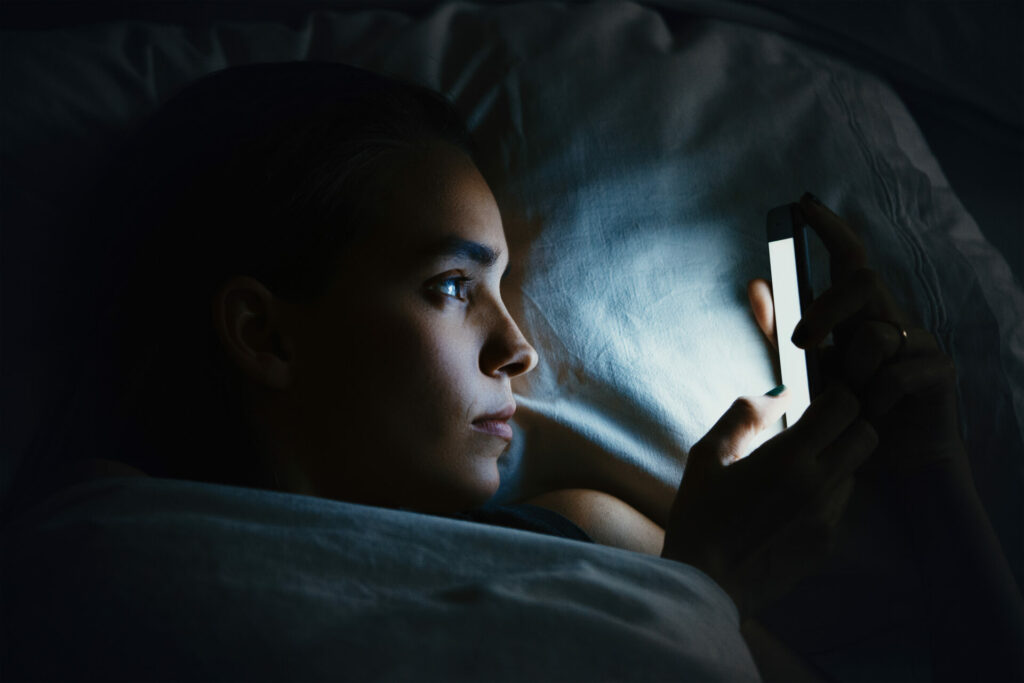The moment Maddie wakes, she reaches for her mobile phone. Still stretching, yawning and half asleep, she starts to scroll through WhatsApp and text messages that have come in overnight. Soon she’s on Insta, TikTok and Facebook. Before she even gets up, she’s checked her two email accounts – work and personal, and started replying.
‘I feel like I can’t help it anymore,’ confides 29-year-old Maddie, a property lettings agent who is glued to her phone from dawn until dusk each day. ‘It’s become a kneejerk reaction to any thought or feeling or comment. Everything people say or do seems to remind me to check my phone. I don’t want to miss a thing. I fear I’m developing a digital addiction.’
The irony is Maddie may be completely up to date on social media and her emails, but she’s missing out on everything in her real-life world, including important moments like her toddler son Bertie taking his first steps and her mum’s early hints at an illness that has now worsened.
Missing Out

She’s so busy filming content for her socials she half catches speeches, celebrations and concerts. Then there are the things Bertie points to when he’s in his stroller, the beautiful countryside on their holiday in Italy and her husband Pawel’s affectionate gestures.
And Maddie is far from alone. She’s one of millions suffering from digital addiction. In 2022 we spent an average of 399.5 minutes a day online – that’s more than six hours, while the average American spends seven hours a day looking at a screen.
Dubai life coach Adam Zargar paints a shocking portrait of the average adult’s typical day, from the moment we wake to the minute we close our eyes to sleep.

Adam, Director of UAE Coaching, says: ‘The first thing people see in the morning is their messages. During the day, they’ll go down the rabbit hole that is emails and they will fire-fight tasks from that. They check messages and answer calls and are left wondering why they can’t complete their to-do list.
‘We are emotionally overloaded with notifications, tasks, reminders and information, and this causes so much stress and anxiety. Our social lives are more online, so we end up missing deep human connection and interactions’
‘If they go for a walk, they won’t stay present and see, hear and touch – they look down and scroll and type. Their baby may be smiling and playful, yet they won’t be seen or heard.
‘When they’re home with their spouse or children, they half listen while they’re on their phone or in their own head. If they switch off, they watch Netflix. They go to bed late and look at their phone while their partner goes to sleep. Eventually, they sleep, but if they’re restless, they look at their phones and become more awake. The average adult will cuddle their phone at night.’
Digital Addiction

And the effect of having no digital off switch? Adam, who coaches high performers, explains: ‘We spend hours dumbing ourselves down, instead of connecting and growing. The phone and screen have started to manage us, and we are becoming 24/7 non-present for the things and people that matter most.
‘We are emotionally overloaded with notifications, tasks, reminders and information, and this causes so much stress and anxiety. We’re always accessible so our work follows us home. Our social lives are more online, so we end up missing deep human connection and interactions.’
UK life coach Phil Olley agrees the way we use our digital devices affects all areas of our lives, from a lack of exercise because the only part of our body we move for long periods is our thumbs, to an inability to focus on any one thing for longer than a minute.
‘Digital overuse isolates us, and that leads to loneliness and depression,’ says Phil, author of Reflections from the White Tunnel (FCM Publishing). ‘Because we have long periods of inactivity, whether we’re slumped in a chair on Facebook, or lying in bed on Instagram, we’re not releasing endorphins, those feelgood hormones. We scroll with no focus, and eventually nothing can hold our attention.
‘As well as altering our minds, digital devices are robbing us of time. The hours and minutes go fast once you engage with social media. Some people spend hours and hours per day on their phones, obsessively posting, scrolling and checking who’s liked their posts and who hasn’t.
‘These electronic devices are creating a dependence that’s like a digital addiction. We’re like the dogs in Pavlov’s experiment. A notification goes off and we respond, constantly interrupting our thought patterns’
‘The digital world has been very bad for our peripheral vision. Now many people’s world is contained within a few inches in front of their face. We’re becoming less observant of the world and other people, as we engage with this soap opera on our phones.
‘These devices are creating a dependence that’s like a digital addiction. We’re like the dogs in Pavlov’s experiment. A notification goes off and we respond, constantly interrupting our thought patterns.’
Worryingly, there’s also a knock-on effect for our real world relationships from this global digital addiction and Adam Zargar predicts these will decline in the digital age.
‘We’ve never been more connected with the world, yet at the same time disconnected with our loved ones,’ says Adam. ‘We’ve replaced the good morning kiss with checking our phones. Walks and lunches are no longer about chatting and listening – they’re about posting on Snapchat and Instagram. Good communication is vital, yet we’re no longer present with loved ones. Even intimacy will be replaced by phone interactions.’
So, with everything we hold dear at risk, how can we halt this digital addiction in its tracks? Adam and Phil have some tips.
Embrace Nature

Widen your vision by exploring nature, suggests Phil. ‘Get out in the great outdoors, walk or cycle and really open your eyes. It’s the complete opposite of digital life. You’ll feel calmer and more at peace with yourself and the world afterwards. If that’s too much of a challenge, go for a walk after dinner – without your phone!’
Distance Yourself

Sometimes it’s just too easy to scroll when your phone is to hand, so put some distance there, suggests Phil.
‘Put your phone, tablet or iPad in another room to charge, maybe for a whole day,’ he says. ‘Don’t worry. If there’s an emergency, people will call you and you will hear your phone ring.’
Manage Your Time
Be in control of your screen time, rather than at the mercy of it, says Adam. ‘Schedule time to look at your devices and stick to them. Maybe for five or ten minutes each hour through the day, you could check messages. That way, you won’t miss anything, yet you can focus clearly in between.’
Have Some Rules
Draw up some boundaries within your family about when and where phones and other gadgets are acceptable, recommends Phil.
‘You might choose to ban them from the dinner table at mealtimes or in the bedroom late at night,’ he says. ‘Whatever you decide, stick to it, so you set an example for everyone.’
Keep Tabs On Time
Being aware of how bad your digital addiction has become is the first step to overcoming the issue, according to Adam.
‘Set a widget that shows how much time you have spent that day on your screen,’ he says. ‘Simply seeing the total as a period of time may change your outlook and make you check it less.’
Do A Detox

Phil suggests challenging yourself to a 28-day digital detox. ‘You may need screens and digital devices for work, but having a whole month off social media would change your scrolling habits in the long run,’ he says. ‘Use you extra time – often several hours a day – to get fit, do up your garden, do a beach clean or take up a new hobby, such as photography.’
Turn Off Early
Have at least 1 hour or 1 hour 30 mins of non-electronic time before bed, advises Adam. ‘Just doing this and cutting out the blue light will tell your brain it’s time to sleep,’ he says. ‘Sticking to this rule and keeping it constant is the best way to guarantee a good night’s sleep.’
Attack That Inbox
Devise a system to deal with emails and regain a sense of control, advises Phil. ‘Email overwhelm stops us from focusing on the most important things and people wear their emails with pride, boasting about getting 400 a day. You can file emails, act on them, refer them or put them in trash. At the end of every week aim to get your Inbox to zero. You’ll feel lighter and in control.’
Get Appy!
Accountability is king so use an app to set a goal for your digital use to curb digital addiction, suggests Adam. ‘Tracking means you can see which apps you are using and for how long,’ he says. ‘You could compete with a friend or loved one to cut down your digital time. Remove the apps that don’t serve the person you want to be in the long term.’
See Real People!
Instead of mindlessly liking posts on social media, manage your digital addiction by meeting up with friends in real life, recommends Phil. ‘Pop round to their apartment and chat about their recent holiday or promotion,’ he says, ‘or have a coffee so you can tell them about your new job. If you can’t meet up, chat by phone or even write them a letter. A handwritten letter is wonderful to receive!’
For more wellbeing and health features please visit our SELF section













